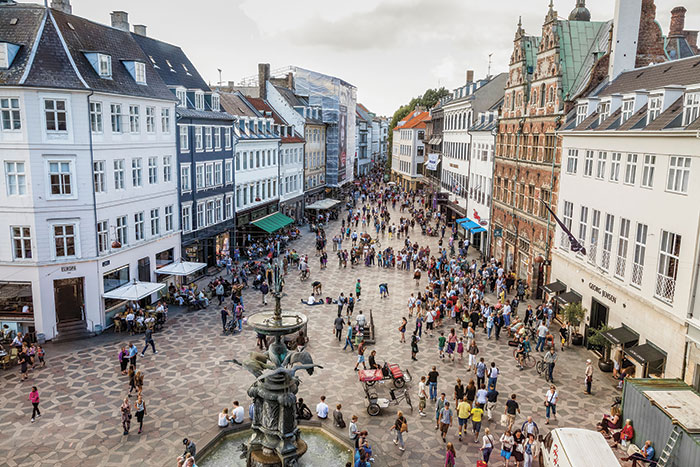Free, universal healthcare and elderly care, good-quality education at all levels – without a price tag, generous benefits and a strong labour market with high salaries and living standards: it’s no wonder the Nordics have become the poster-boy for what a liberal cradle-to-grave welfare state looks like.
Like many systems, the Nordic system is, in the main, funded by taxes. Yet Scandinavians – who are also said to be the happiest people in the world – rarely complain and are generally happy to pay their share. In Denmark, for example, tax rates are among the highest in the world, with tax revenues accounting for almost half of the national income. By comparison, in the US, they account for around just 25%, and, according to the Institute for Fiscal Studies, approximately 34% in the UK.
Even US presidential candidate Bernie Sanders, now set to run for a second time, wants to bring a Nordic-like utopia to his side of the pond. Although this vision didn’t make him president in 2016, it did put the welfare model – and the Nordic countries – in the spotlight.
Despite these perceptions, some cracks have emerged over recent years. Following the 2008 financial crash, the Scandinavian welfare state started to shrink. General government expenditure has decreased, albeit slightly, in recent years, and hospitals and job centres have been shut down across the region. Norway has a huge sovereign wealth fund – the world’s largest, with over $1trn in assets – to fall back on. But Finland, which has also struggled to recover from the financial crisis, remains under scrutiny – most recently for the government resigning over a failure to agree on healthcare reforms.
So, does the so-called Nordic model still exist? Perhaps Denmark and Sweden offer the best indications.
According to the OECD, total Swedish government expenditure was 49.3% in 2017, showing little change since 2015, when it was 49.6% of GDP. In Denmark, it fell from 55% of GDP in 2015 to 51% in 2017 – just slightly more than the average for OECD countries, where government expenditure declined by 3.3 percentage points.
But while other countries are busy building hospitals, 5.7 million Danes have just 32 hospitals to share – less than half of the 98 that existed in 1999. The Danish government also announced last year that it was planning to slash 20% off funding for Danish public service media – known as DR – and the 2019 budget revealed almost no spending increases compared with 2018.
Likewise, in Sweden, some areas of the public sector have also faced cuts. In March, the Swedish Public Employment Service announced that it would close 130 of its 242 local job centres across the country. This came a month after it announced that it would lay off around 4,500 of its staff, as a result of cuts revealed in the budget for this year.
On the face of it, these figures suggest the welfare state is facing funding shortages and even collapse. But dig a little deeper and the picture is shaping up quite differently. Rather than simply facing resource cuts to welfare services, these countries are reforming their systems to make them more efficient and sustainable – and getting more bang for their buck in the process.
“We have seen budget cuts in certain areas – and there are always budget cuts going on to force different organisations to work more effectively, but I wouldn’t call it austerity,” Jakob Blicher-Hansen, head of infrastructure, government and healthcare at KPMG in Denmark, tells PF. “What some people consider cuts are not really cuts but most often reforms aimed at delivering services more effectively and efficiently.”
The welfare system remains a priority for both Sweden and Denmark. In fact, social expenditure on services – which are publicly funded but delivered by the private and the public sector – and benefits is still relatively high in both countries, at 28% and 26% of GDP respectively. That compares with a 20% average across the OECD.
'Even though there have been some cuts in public expenditure, the share of expenditure to welfare protection, health and education has not decreased. This is something that is kept at the same level.' - Pauline Fron, OECD statistician
Pauline Fron, OECD statistician, says the Nordic countries are “still unique” in terms of the share of their GDP they invest in benefits and services: “Even though there have been some cuts in public expenditure, the share of expenditure to welfare protection, health and education has not decreased. This is something that is kept at the same level.”
John Hassler, economist and professor at the Institute for International Economic Studies at Stockholm University, says Sweden, with a population of just under 10 million, is still a welfare state – despite adding that it is “not as generous anymore and does not necessarily stand out” compared with other European countries.
“We have seen over a couple of decades a reduction in the generousness of the system,” he says. “While that has not come through cuts, the payments in unemployment insurance, benefit systems and so on has not been raised at the same pace as other areas. That said, the number of people working has also increased since the 1990s, with about 82% of the working population in employment now, compared with 75% back then.”
David Sundén, managing director at Lakeville Economic Consulting in Sweden, echoes this: “Sweden is definitely still a welfare state. And should continue to be one – there’s no political disagreement about that.”
But both Swedish economists agree that Denmark is more generous in this area. And the OECD figures speak for themselves: Denmark is spending 28% of GDP on benefits and services now, compared with 25.4% in 2015. And despite hospital closures there, the Danish government is actually spending more on health than it has in the past – 6.7% of GDP compared with 5.8% in 2005.
Blicher-Hansen explains: “That we have seen hospitals shut down at the same time as spending has been increased is an example of the reform programmes. The agenda is for reforms that deliver services more effectively and efficiently.”
Constant change and reforms are crucial to keeping the welfare state sustainable, the economists tell PF. Policymakers in both countries are focusing on boosting efficiency within the public sector in order to tackle current challenges, including ageing populations and shrinking working populations.
p36-40-scandinevia-city-centre-copenhagen-alamy-dk8860-.jpg

Copenhagen model: despite efficiency cuts, the Nordic countries are 'still unique' in terms of the share of GDP they invest in benefits and services
Torben Andersen, economics professor at Aarhus University in Denmark, says that the Danish government has been reforming health provision for some time now, including shifting hospitalisation powers back to the state.
“Policymakers are increasingly focusing on efficiency and productivity within the public sector, which can help create fiscal room,” he says.
Similarly, the job centre closures in Sweden did not result from a lack of money, Sundén explains, but because “they were seen as inefficient by the centre and right-wing parties”.
The efficiency reforms include new IT systems. In Sweden, citizens can declare their taxes by simply texting ‘OK’ in response to a text message containing a tax statement automatically produced by the tax authorities, Hassler says.
Similarly, Denmark has also looked to change the way its tax authorities work. Cutting the tax budget a couple of years ago caused “massive problems”, according to Blicher-Hansen. Since then, the government has put more money back into the system – including investment in new IT systems and reorganisation. The latest budget for 2019 included Kr600m (£70m) for this.
Constant reforms to boost efficiency are clearly a major aspect of Scandinavian public sector policy – and something other regions are likely to continue to monitor. Policymakers around the world also face the challenge of ageing populations.
But it takes time. The fact that people are living even longer in Denmark and Sweden isn’t a fiscal problem, because the pension systems in both countries were reformed in the 1990s to deal with this future challenge. Hassler says this was “an automatic response” to the changing demographic and the result of a system that “is robust to demographic changes and lower economic growth rates”.
The Vikings are dealing with impending difficulties head on, before they become a problem. That doesn’t mean the retirement age isn’t also changing in Denmark and Sweden. Blicher-Hansen says that, as the population gets older and enjoys an increasing number of healthy years after retirement, it is “natural” that the retirement age increases. The plan is to gradually increase it to 67 over the next few years, and to 68 by 2030.
Jens Sand Kirk, chief adviser at the Centre for Analysis at Local Government Denmark, a member organisation of the 98 Danish municipalities, adds: “As in many other countries, Denmark’s public finances are challenged by an ageing population. But, thanks to ambitious pension age reforms and comprehensive private pension saving schemes, long-term public finances are solid.”
The real Nordic challenge is now boosting productivity to keep the sector running. Sundén, who has in the past advised the finance minister of Sweden, tells PF that, according to his calculations, “manpower” in the public sector in Sweden needs to increase by as much as 215,000 by 2030. The public sectors in both countries are huge, employing close to 30% of the working population, which means that as people of working age become fewer, the number of employees could fall.
“If we want to keep today’s level of quality of the welfare services, the public sector needs to hire more people and increase productivity,” he explains. “If we can’t increase productivity, we might run into trouble.”
Technology may be the hero here, however, and both countries are exploring ways in which automation could help to boost productivity.
It is clear that the Nordic model isn’t going anywhere yet – as long as it can be sufficiently powered and continue to adapt.
The Nordic star?
With a population of just 5.3 million people, Norway is one of the richest countries in the world. According to the International Monetary Fund, its net worth amounts to 340% of ‘mainland’ GDP, which excludes oil and gas exploration and transport. And, based on new calculating methods from the World Bank, which uses wealth per capita as a ranking mechanism, Norway is now wealthier than Qatar.
The country also sits among the top countries in OECD rankings for wellbeing and citizen satisfaction in healthcare, education and trust in the system.
It is also a world leader in digital transformation of the public sector.
But the central bank and the conservative government have repeatedly warned of tougher times ahead. Although it has recovered since the oil price collapse of 2014, there has not been enough growth in the tax base to sustain the levels of some services – from sick leave and daycare centres to free university education and hospitalisation.
In March, the Norwegian government announced its intention to sell its trillion-dollar sovereign wealth fund’s stakes in oil and gas exploration and production. The move is intended to protect the Scandinavian country’s economy against oil-price falls. Norway’s Government Pension Fund Global is the world’s largest sovereign wealth fund and manages $1trn of the country’s assets.
Recently, a survey, conducted by Norwegian research firm Opinion for employers’ organisation Spekter, revealed that 51% of the population questioned the future of the welfare state.














